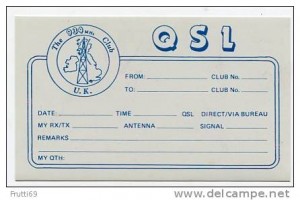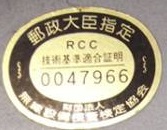HISTORY (UK, SWISS, DUTCH & JAPAN)
United Kingdom

In the UK On the 2nd of November 1981, two separate CB bands were legalised. Forty channels on 27MHz FM, on different frequencies to the AM rigs that were being widely used illegally and 20 channels on 934MHz. FM.
934Mhz UHF frequencies so high up the spectrum were considered pioneering territory back then. There were no commercial mobile radios around that frequency from which cheap parts could be borrowed to manufacture CB sets. Nobody had made any suitable radios for anywhere near 934MHz. But credit where its due, a British company called Reftec got a set into production pretty much straight away. You could be on the air on 934MHz with a basic “3 knob” set for about £400. Compare this with a cost of under £100 for a similar 27MHz set up and you’ll see why uptake was slow at first. That was of course until it was realized just how good the band was.
You were allowed to use 8 watts and beams and base to base signals were very good, but for mobile use it was a little unpredictable and definitely an enthusiasts choice rather than for the non-technically minded. But despite this, 934 developed a dedicated following. Japanese manufacturers soon jumped aboard the bandwagon and more models of radios became available. As well as more British offerings from Uniace and Grandstand. The ubiquitous Cybernet Delta One became the standard choice of the 934MHz operator.
Due to the high cost of 934MHz equipment. On air conduct was exemplary and made even the amateur bands appear unruly. Some 934MHz operators were licensed radio amateurs who found the laid back but polite approach, without the need for call-signs or log keeping most agreeable. Most did use call-signs though. The UK934 club was very successful and at one time most 934 operators were members of the club and used the UK1234 style call-sign. The club had a QSL bureau

and ran contests and activity days.
By the mid 1980s all the major population centers had regular on air group nets.
The future of 934 was looking bright. The 20 channels were 50KHz spaced, but the maximum deviation was more in keeping with a 25KHz spaced system. It was very noticeable that 934 had been designed to be easily expanded. 934 could easily become a 40 channel service. Some technically minded folks noticed that the radios circuitry was designed with this in mind. Everyone thought it was only a question of time until 934 grew an extra 20 channels.
But in 1988 things turned sour. The authorities had a rethink. The old FCC 27MHz channels were legalized on FM as the new CEPT channels and 934 was restricted. No more 934 sets were allowed to be manufactured or imported although existing radios could still be used. There was only around two thousand 934 radios in the country at this point and its 20 channels which occupied a whole one megahertz, was taking a lot of spectrum away from other possible uses. So despite the government originally wanting 900+MHz to be the only CB band, they decided 934 would have to be put to other uses.
A lot of the 934 crew gave up in disgust and many returned to 27 or 144MHz. Some still soldiered on knowing the band would only have less and less use. The UK934 club kept on going for as long as it could until lack of interest closed it.

Five years later In June 1993 came the announcement that 934MHz would be withdrawn as a CB band. The New use would be Digital Short Range Radio (DSRR). From this point 934MHz CB sets could continue to be used for there foreseeable life expectancy . The new system did include a CB type service for both business and private use. This would have let the existing 934 sets use part of the DSRR system. It incorporated many features of the Japanese radios. Sadly uptake was virtually nil for this new service. Manufacturers were nervous after the withdrawal of the 934MHz CB service . It was this change of use that spelt the end of 934MHz and not that the frequencies were given to mobile phones as widely miss reported on internet forums. The frequencies were of course given to the mobile operators at a later date due to lack of use / uptake of DSRR.(The service was given 5 years to materialize) The new fangle mobile phone systems appearing were of more appeal to business users than a mobile radio system with short range. The “Nail was slowly being driven into the coffin” for 934MHz.
Had DSRR materialized, it would have saved 934MHz What a shame Manufacturers didn’t put enough effort into it. Click the images to read all about it here.


The 934mhz Club UK was folded and a New club emerged to promote and keep alive interest in 934MHz by promoting DSRR. This Club was the “The Personal Radio Club of Great Britain 934MHz”

The 31st December 1998 was the last day for legal use of 934MHz. Some 10 years after the announcement of DSRR and restriction on import and manufacture. 10 Years extra operating grace that I for one enjoyed to the full and till the end.
Terry
But Britain is not alone in its use of UHF CB in the 900MHz region. Switzerland had a 933/934Mhz CB/Personal Radio allocation, Japan has a 903/905MHz CB/Personal radio allocation. The US had an Amateur radio allocation close to both services. The Netherlands also had their famous Pirate 934MHz operations as well as some use in Northern France, Germany and Guernsey.
Switzerland


Radio Club Neuchatelois 934MHz
Represented the interests of 934MHz users in Switzerland. Like the UK counterparts they also organized contests and were a very active group. When 934MHz was withdrawn they cut the 934MHz from the bottom of there logo as seen above. (anyone got a copy with it still attached). It is displayed like this to this day on their website.
The Swiss band had 80 channels. 40 at 934MHz for CB and 40 at 933MHz for Public radio service
Band A: 933.0125-933.9875 MHz
Band B: 934.0125-934.9875 MHz
Swiss-CB-Organisation

- 1979 Foundation SCBO
- 1981 Submission of studies of concession 933/934 MHz
- 1982 Introduction of 22 channels with 0.5 watt (AM/FM/SSB) and mobile and base antennas as well as test concession 934 MHz
- 1984 Introduction of 40 channels FM with 4 watt transmitting power test run 933/934 MHz
- 1985 Introduction of the Swiss CB-radio DF (direction finding)contest
- 1986 Introduction of the SCBO Whitsun contest
- 1987 Concession by pay-in slip
- 1988 First examination of a pole-mounted pre-amplifier933/934 MHz
Band closed 2003-12-31
Netherlands
Activity took place illegally from the Netherlands and in the height of the UK 934 activity period. Many contacts were made with UK stations using equipment from both the UK and Swiss bands.
Shown here are some archive pictures from Freddy station UK1799 operating from Holland back then. Along with some of his impressive QSL cards for contacts in to the UK.










Japan

Personal Radio:
- Frequency: 158 channels in 903 to 904 MHz
- Mode: Narrow FM
- MCA (Multi Channel Access) System with ROM (Read only memory)
- Output power: 5W or less.
- Usage of external antenna is allowed up to gain of 7.14dBi, but it must be non-directional or horizontal plane. Usually, a vertical 1/2 wave or vertical stacks of 5/8 wave is utilized.
- No qualification required. License for station is required, but it is just a matter of application.In 1982, the government introduced the usage of radio in 903MHz to support better communications mainly aimed for automobile drivers and passengers. They were also used in the business scene, such as in communications between a base station and mobiles, where a private or small sized company managed employees using cars for services, deliveries etc. People were enjoying the radio, of course, as hobby use to make QSOs like CB radio. The usage of the radio got to the peak as the number of stations climbed up to more than 2 million in early 90s, but it sharply declined after people came to generally use cellular phones. Another reason for the decline was in the MCA system, which did not allow the user to select channels easily, awkward for hobby users who usually wanted to “manipulate” the radio. (Illegal mod ROMS did allow this though)
The industry formed an association for the Personal Radio (PRPC) to recommend the usage of legal antennas so that stations would not abuse the use of directional antennas like Yagi’s, which are illegal. Those antennas recommended by PRPC had an orange color part somewhere on the antenna, to make it distinct from other antennas, including illegal ones. Because the orange color parts very often appeared on the top, the Personal Radio was commonly called “Orange Top”.
5W of power, almost without any license, still attracts Japanese users, however, few if no manufacturers are currently supplying the radio. Apart from a massive amount of second hand radios, you can frequently find brand new radios in the web auctions from over stocked inventories.